
Layne once collected rifles in 22 Hornet and still has several. This 1930s vintage Winchester Model 54 is one of the more accurate he has shot. As was typical in those days, its barrel has a groove diameter of .223 inch and a rifling twist rate of 1:16. Stocked by Hart Arms Company of Cleveland, Ohio, the rifle has an early Weaver K10 scope once favored by many serious woodchuck hunters.
The 22 Hornet story began during the late 1920s when Grosvenor Wotkyns, who was a member of the ordnance department at Benecia Arsenal in California, began experimenting with the 22 Winchester Center Fire (WCF) case. When Winchester introduced the cartridge in 1885 for the company’s Model 1885 single-shot rifle, it was loaded with black powder and a 45-grain lead bullet at a velocity of 1,540 feet per second (fps).
Wotkyns loaded the 22 WCF case with DuPont 1204 smokeless powder and 45-grain jacketed bullets made by Remington for the 22 Velo-Dog cartridge. The velocity was approaching 2,000 fps. At the time, Colonel Townsend Whelen was the commanding officer at Springfield Armory in Springfield, Massachusetts, where firearms for the U.S. military had been designed and manufactured since the Revolutionary War. Soon after learning about Wotkyns’ work in 1929, Whelen mentioned it to pals A.L. Woodworth and George Woody, who were also employed at Springfield Armory. At that time, the 1903 Springfield in 30-06 was the U.S. service rifle and a 22 Rimfire version called the 1922 Springfield was used for training purposes.
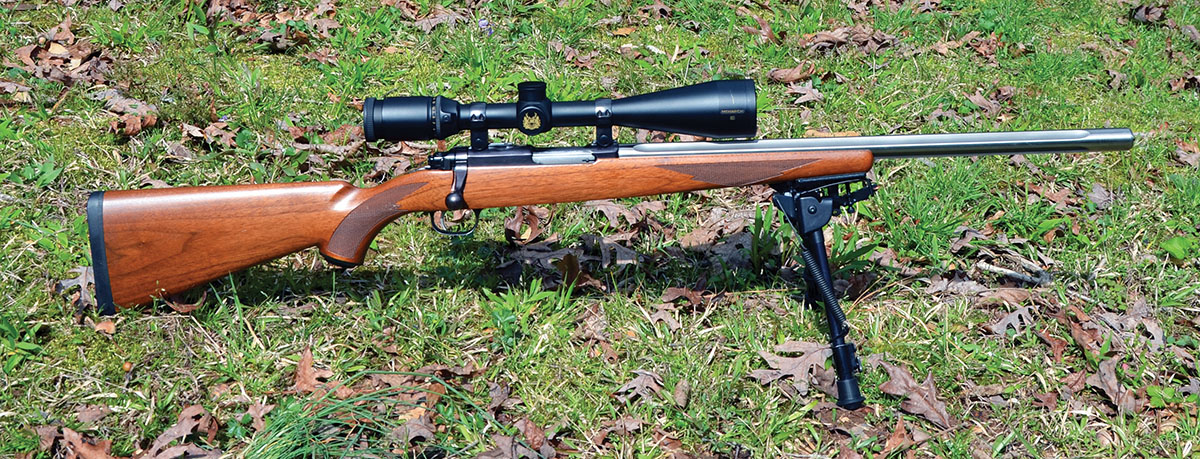
This extremely accurate custom Ruger Model 77/22 was built in 1996 by Jim Clark Jr. of Clark Custom Guns and it is Layne’s favorite rifle in 22 Hornet. Its trigger breaks crisply at 24 ounces and the heavy, 20.75-inch barrel was made by Dan Lilja. With a Nikon 4-16x scope on board it weighs 8.6 pounds.
One thing led to another and three of the four “Ws” decided to convert the bolts of 1922 Springfield rifles to centerfire and rechamber their barrels to 22 WCF. The groove diameter was .223 inch, so a set of dies were made to form 45-grain lead core bullets of that diameter with jackets made from spent 22 Rimfire cases. The rifling twist rate was 1:16. Shooting the converted rifles in a machine rest produced groups measuring as small as 2 inches at 110 yards, which was exceptional accuracy in those days. At the time, DuPont 1204 was the only suitable powder available, so Whelen coaxed friends at Hercules Powder into developing a propellant capable of higher velocity from the 22 WCF case. He got his wish and since the new powder pushed a 45-grain jacketed bullet along at a velocity of 2,400 fps, it came to be called Hercules 2400.
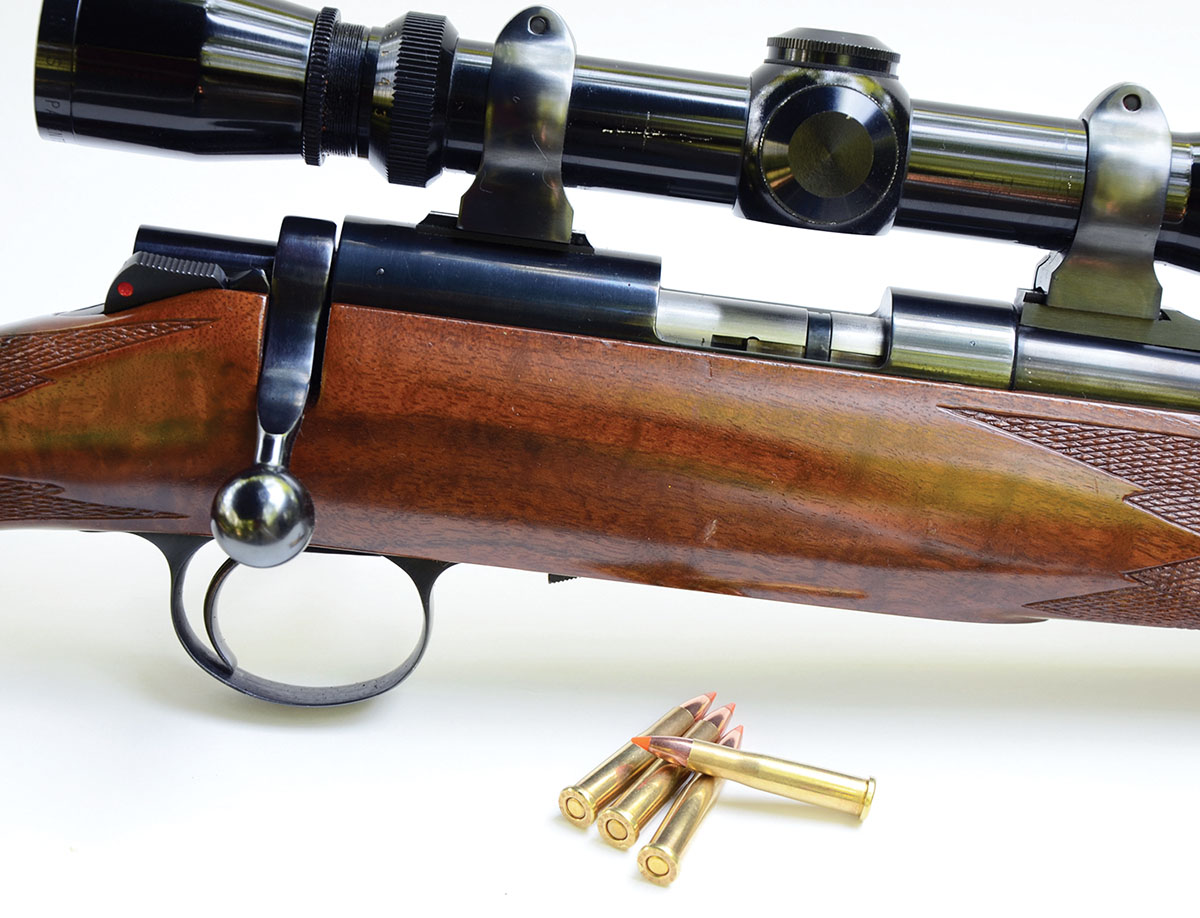
The Kimber Model 82 with its barrel groove diameter of .224 inch and a rifling twist rate of 1:14 was largely responsible for the revival of the 22 Hornet. Layne added this one to his varmint battery in 1982, the year it was introduced and it proved to be quite accurate.
The spring of 1930 found Whelen and his buddies using their 1922 Springfield rifles to bump off woodchucks in northern Massachusetts. Woodworth bagged the first one, prompting Whelen to remark that the cartridge had the sting of an angry hornet. Winchester executive Edwin Pugsley, became interested in the project and after his technicians shot the cartridge in a Model 54 rifle, it was described as the most accurate centerfire cartridge tested by the company up until that time. Winchester moved quickly and introduced 22 Hornet ammunition in 1931, loaded with two 45-grain bullets, one a softnose, the other a hollowpoint, both at 2,500 fps. The introduction was made easy by the fact that Winchester was still producing 22 WCF cases so the headstamp was simply changed to 22 Hornet. Savage was the first to chamber a rifle for the new cartridge and why Winchester waited until 1933 to offer it in the Model 54 remains a mystery. When that rifle was improved and reintroduced in 1936 as the Model 70, the 22 Hornet was among its chambering options. Moving to the year 1949, the new Winchester Model 43 bolt action was offered in 22 Hornet along with the 218 Bee, 25-20 Winchester and 32-20 Winchester.
Experienced northeastern shooters of the 1930s and 1940s considered the 22 Hornet an honest 150-yard woodchuck cartridge. This took into consideration the accuracy of rifles in those days, which at their best, often struggled to shoot five bullets inside an inch at 100 yards. Custom bullets from several small makers also varied in accuracy. The availability of more accurate rifles and bullets today, along with better powders for reloading, has added a good 50 yards to the effective range of the 22 Hornet but very little more than that. Let’s take a look at a few facts and figures.
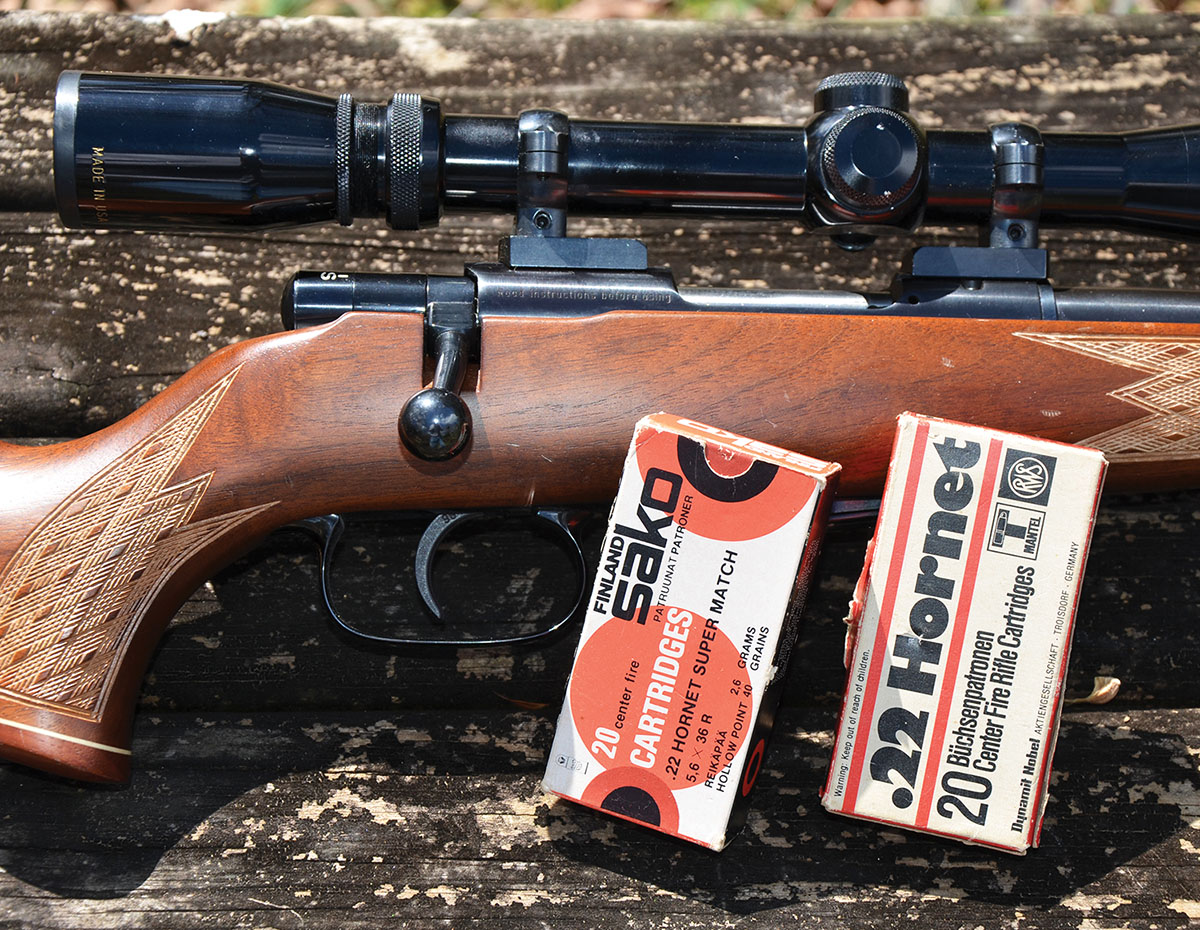
The 22 Hornet is still quite popular in other countries where it is often known as the 5.6x35R Vierling German and British hunters often used the cartridge to take roe deer while those in Scandinavian countries favor it for bagging capercaillie, the largest member of the grouse family. Shown here is an Anschutz 1730 rifle chambered for the cartridge.
With the Hornady 40-grain V-MAX exiting the muzzle at 2,800 fps and zeroed 2 inches high at 100 yards, it strikes an inch below the point of aim at 200 yards and is 13 inches low at 300 yards. Okay, you have an accurate rangefinder and a scope that allows you to quickly click up and hold dead on at 300 long paces. While doing so might extend the hit range of the 22 Hornet, it does not increase its effective range. Residual velocities of that same 40-grain V-MAX moving out at 2,800 fps are 2,350 fps at 100 yards, 1,940 fps at 200 yards and about 1,600 fps at 300 yards. Now, once the velocity of most jacketed rifle bullets drops below 2,000 fps, expansion can range from very little to not at all. Some will expand slightly down to 1,600 fps but they have lost their explosive impact on varmints.
The 22 Hornet enjoyed great popularity during the 1930s and on into 1940s and despite the eventual introduction of faster cartridges such as the 220 Swift, 218 Bee and 219 Zipper, it managed to hang onto its share of varmint-shooting fans. Then came the 222 Remington in 1950 and for about the next three decades, the Hornet became almost a forgotten cartridge and it remained so until various firearms companies decided to bring it back.
The introduction of the Ruger No. 3 single-shot during the early 1970s gave the Hornet a boost, but the rifle that really brought it back into the limelight was the Kimber Model 82. I received one of the first built in early 1982 and still have it. At the time I collected rifles in 22 Hornet and had shot most of the American makes as well as several made in other countries; the Kimber shot right along with the best of them. Not long after Kimber got the bandwagon rolling, Browning, Savage, Ruger and Ultra Light Arms hopped aboard with their bolt-action rifles.
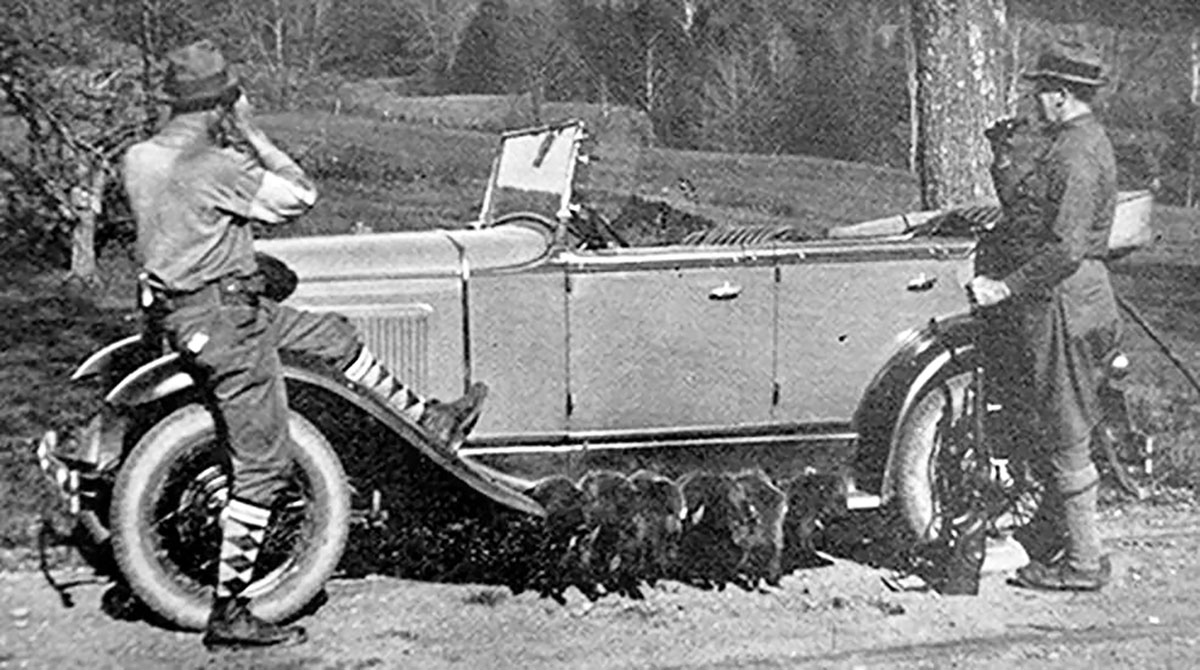
In 1929, Colonel Townsend Whelen, at right with friend Paul Estey, used custom rifles in 22 Hornet on the 1922 Springfield action to bag the six woodchucks shown here placed on the running board of their automobile for photographing. Whelen was instrumental in the introduction of 22 Hornet ammunition by Winchester and Estey authored The Woodchuck Hunter, one of the first books published on the subject.
The 22 Hornet is an excellent candidate for handloading, but take note of the fact that virgin cases almost always vary a bit in length. So the first important step toward accuracy is trimming all of them to the same length. That works out to 1.392 inches for the Nosler cases in my loading room. Important step number two is deburring and chamfering. After the cases have been fired, do not full-length resize if they are used in the same rifle. Instead, use a neck-sizing die and size only about .200 inch of the neck. Leaving the remainder of the neck unsized will leave its diameter close to the same diameter as the neck of the chamber and this greatly improves alignment of the bullet with the bore.
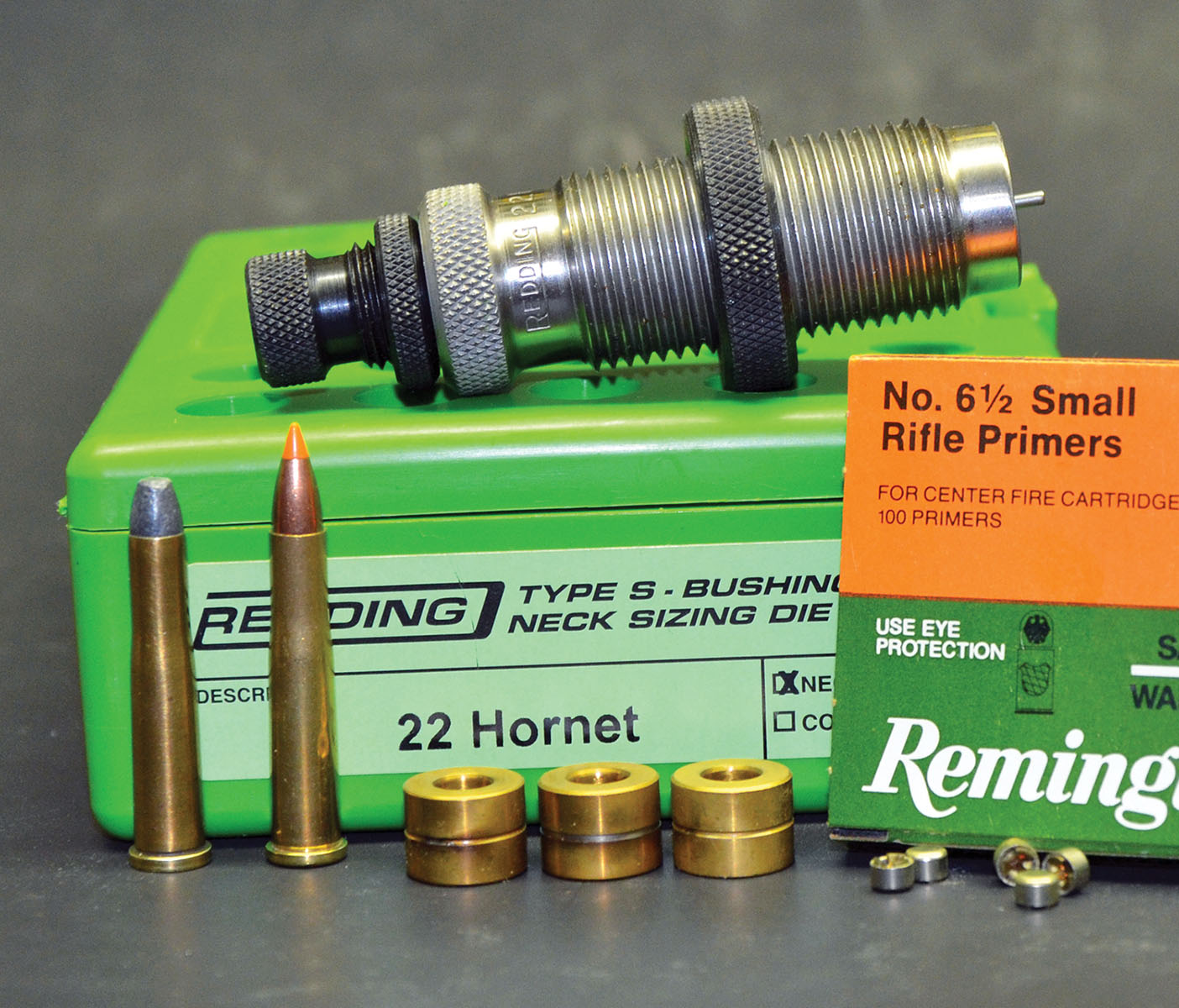
As explained in the text, accuracy often improves when cases are neck-sized considerably smaller than the neck diameter of a loaded round. Doing so is easily accomplished with a Redding Type M neck-sizing die with bushings having interior diameters varying in .001-inch increments. The 22 Hornet at left originated during the 1920s by varmint shooters who loaded the old 22 WCF case (far left) with smokeless powder.
The extremely thin neck wall of the 22 Hornet case does not exert a great deal of tension on a seated bullet and this can increase shot-to-shot velocity variation. Increasing neck tension often improves accuracy in an accurate rifle and doing so costs very little to try. After applying an extremely light coat of Redding Imperial Sizing Die Wax to about half of the neck of a case, it goes through a Redding Type M neck-sizing die. The die has interchangeable sizing bushings with interior diameters varying in increments of .001 inch. A good rule of thumb for most other cartridges is to use a bushing .001 inch smaller than the outside diameter of the case neck with a bullet seated. This would be a .240-inch bushing for my Nosler 22 Hornet cases, but to increase neck tension on seated bullets, I use a .236-inch bushing instead. Properly chamfering the mouths of cases will prevent collapse as bullets are seated. It is important to remember that this procedure requires replacing the standard decap rod of the neck-sizing die with a rod available from Redding that does not have a sizing button. In other words, during sizing it punches out fired primers without impacting neck diameter. Annealing case necks every two firings is a good idea.
My favorite propellants for 22 Hornet handloads have long been W-296 and H-110. Old reliable Alliant 2400 is still a good choice, although maximum velocities are usually slower. IMR-4227, Accurate 1680, Power Pro 300-MP and Lil’Gun are worthy of a try. Other primers may work but I prefer the mild-mannered No. 6½ developed by Remington many decades ago specifically for use in small-capacity cartridges such as the 22 Hornet and 218 Bee.
Rifles built in the U.S. in the old days and most built in other countries even today have a rifling twist rate of 1:16, including those built by Anschutz and CZ. Rifles with the slow twist usually deliver their very best accuracy with bullets not much longer than .600 inch. The actual rifling twist rate of mass-produced barrels can and often does vary a bit, so the sure way of finding out what a particular rifle prefers is to try bullets of various lengths. The barrels of several rifles, including the Kimber Model 82, Ruger Model 77/22 and Savage Model 40, have a rifling twist rate of 1:14. They will stabilize bullets as long as those weighing 55 grains but velocity is low, making them less effective on varmints than lighter bullets at higher velocities.
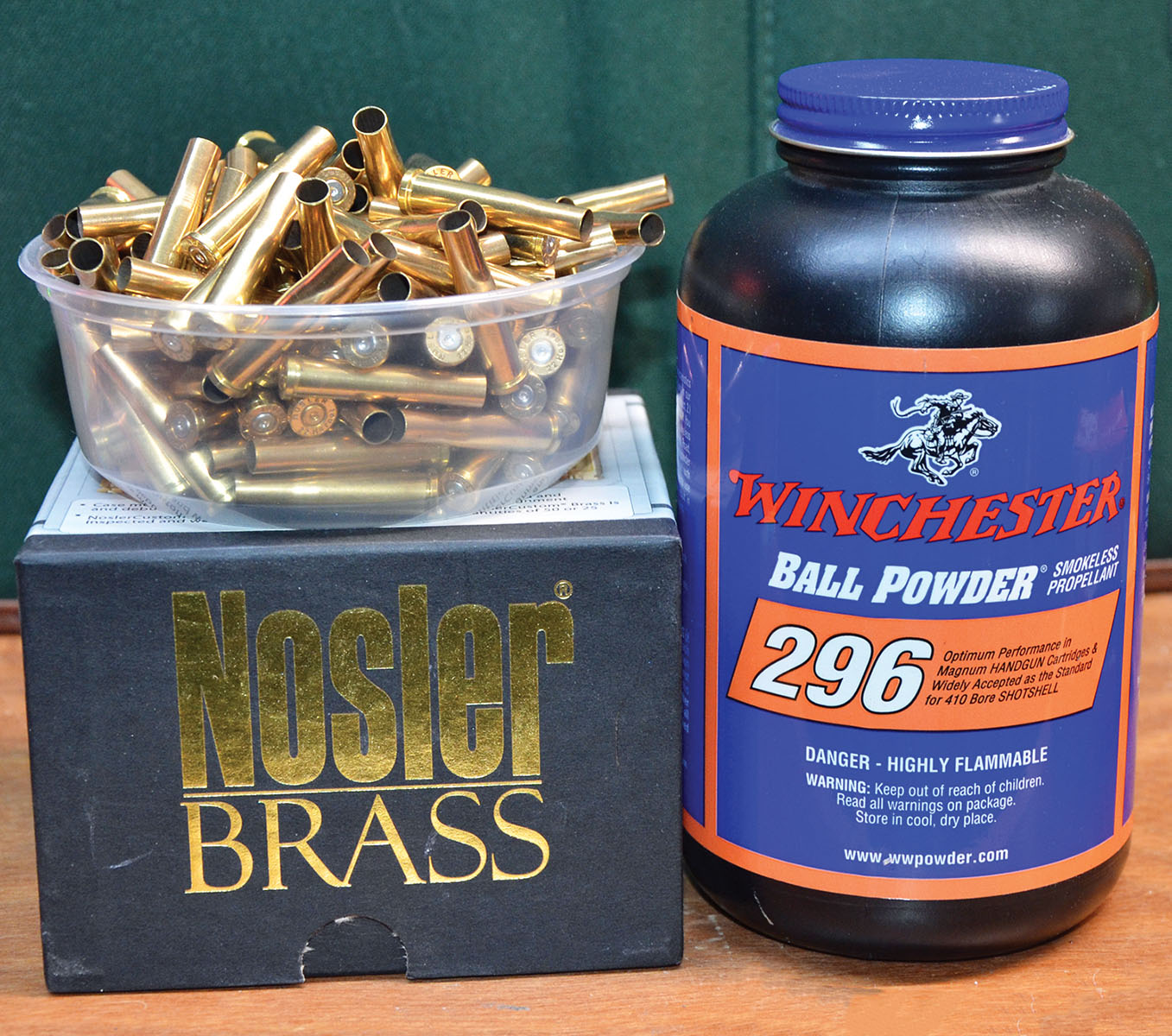
While other propellants are quite suitable for use in 22 Hornady handloads, Layne’s favorite is W-296 or H-110, which is the same powder with a different name. In addition to being quite strong, cases made by Nosler are of excellent quality.
Best bets for expansion on critters are the 40- and 45-grain thin- jacketed bullets from Speer and Hornady, some with “Hornet” marked on their boxes. The even lighter Speer 33-grain TNT can be pushed to impressive velocities, but I seldom find accuracy anything to brag about. Boiling down the choices, I pick the Berger 30-grain hollowpoint, Hornady 35-grain V-MAX, Nosler 35-grain flatbase tipped and Hornady 45-grain Hornet bullets to be the best picks for 1:16-twist rifles. For rifles with the quicker 1:14 twist, the Berger hollowpoint, Hornady V-MAX and Nosler Ballistic Tip, all weighing 40 grains are hard to beat, although the Hornady 45-grain Hornet works there as well.
The barrel groove diameter for older rifles such as my Winchester Model 54 and Model 70 is .223 inch and while bullets of that diameter have been available, my rifles shoot .224-inch bullets more accurately with no sign of increased chamber pressure. Even so, beginning with a recommended starting charge weight of powder and carefully working up while keeping an eye on pressure signs is important. The barrels of more modern rifles have a groove diameter of .224 inch.
The biggest handicap the 22 Hornet suffers today is the magazine length limitations of most rifles when the modern 40-grain tipped bullets are used. The maximum cartridge length for the 22 Hornet has long been 1.723 inches and factory ammunition is usually well inside that. Examples are 1.710 inches for Hornady 35-grain V-MAX and Remington 35-grain AccuTip and 1.700 inches for Nosler 35-grain FB Tipped. Those are perfect for the magazines of older rifles, such as my Winchester Model 54 and Anschutz 1730.
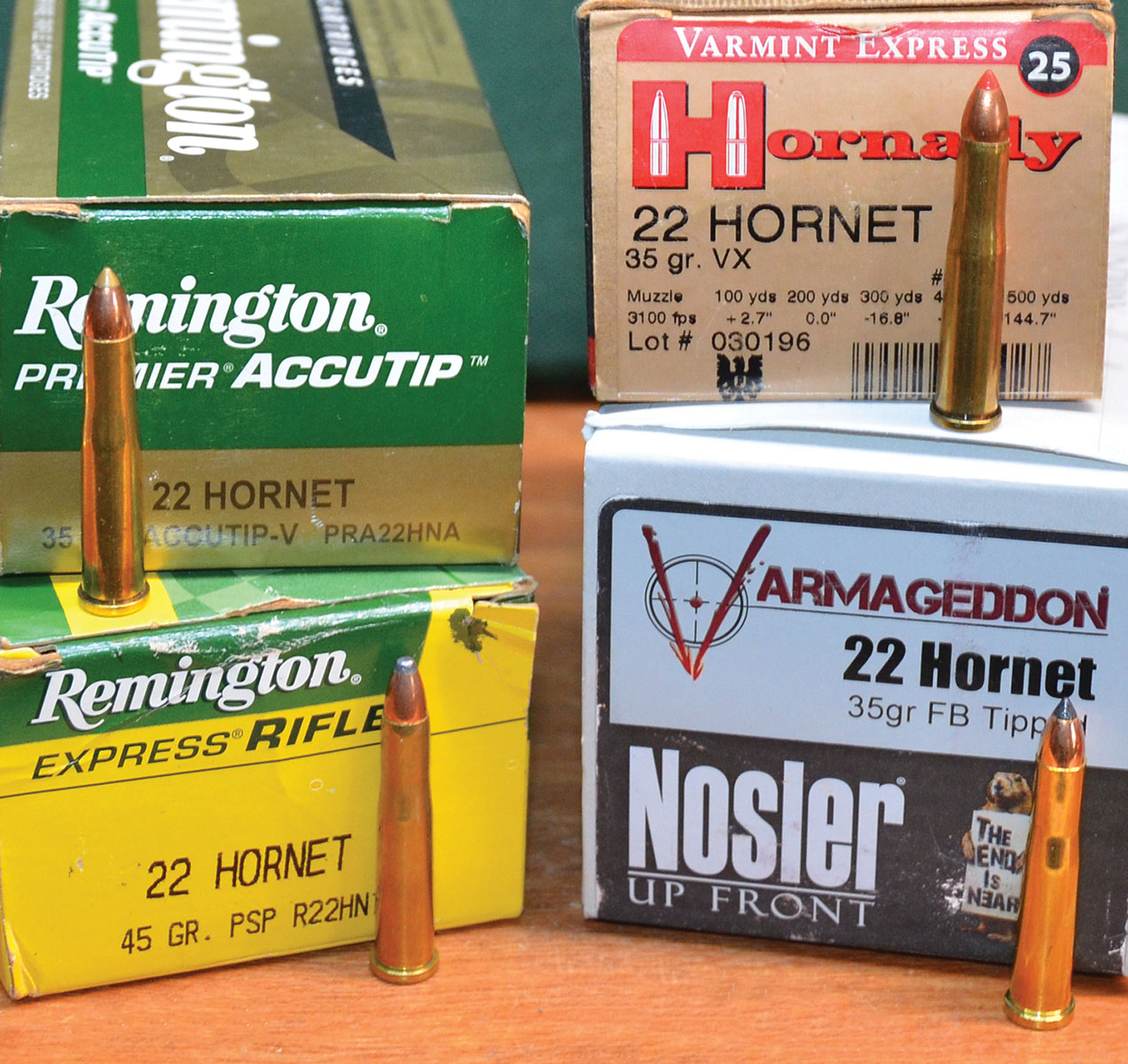
The overall cartridge length of most 22 Hornet factory ammunition does not exceed the SAAMI maximum of 1.723 inches, making them compatible with magazines of both old and new rifles. Bullets are short enough to be stabilized by the 1:16 twist of older rifles while still delivering equally good accuracy from those with a quicker 1:14 twist rate.
The magazines of some rifles, such as the Ruger 77/22 and Kimber Model 82 will handle cartridges as long as 1.80 inches but that’s still not long enough to work satisfactorily when handloading the Hornady 40-grain V-MAX and Nosler Ballistic Tip. If those are loaded shorter than 1.850 inches or so, the mouth of the case is positioned beyond their full-diameter shank and slightly over their ogive. The neck of the 22 Hornet case is much longer than it has to be, so trimming shorter is an easy solution. Another option is to load them long, forego using the magazine and manually load them directly into the chamber. Regardless of what cartridge I am using, I often do so when shooting ground squirrels and prairie dogs. Before leaving the subject, I will mention that NoslerCustom ammunition on my shelf is loaded with the 40-grain ballistic tip at a cartridge length of 1.850 inches. The advertised velocity is 2,850 fps.
The most unusual rifle in 22 Hornet I have is an M4 survival rifle built by Harrington & Richardson from 1949 to 1952 for the U.S. Air Force. It has a four-round detachable magazine, it weighs 4 pounds, and with its barrel detached and its telescoping wire stock closed, it is only 14 inches long. The M4 was part of a survival kit stowed beneath the seat of a military aircraft with the intent of giving the crew of a downed craft a survival weapon for taking wild game for food. You might describe the 22 Hornet as a military veteran that still serves as a fun little varmint cartridge in its civilian life.
Despite the fact that the 22 Hornet is a slowpoke by today’s standards, every serious varmint shooter should own an accurate rifle chambered for it. Recoil is nonexistent and the report is mild enough to keep landowners inviting you back. Most important of all, the 22 Hornet is just plain fun to shoot.

The rifling twist rate of a 22 Hornet barrel dictates the maximum bullet length that will be stabilized in flight with 1:14 twist capable of handling longer bullets than 1:16 twist. Bullets shown here are arranged from shortest to longest: (1) Speer 33-grain HP, (2) Speer 40-grain SP, (3) Hornady 45-grain Bee, (4) Hornady 35-grain V-MAX, (5) Nosler 35-grain FB Tipped, (6) Speer 45-grain SP, (7) Nosler 40-grain FBHP, (8) Hornady 45-grain SP, (9) Berger 30-grain FB Varmint, (10) Berger 40-grain FB Varmint, (11) Hornady 40-grain V-MAX, (12) Nosler 40-grain Ballistic Tip and (13) Nosler 35-grain Lead Free BT.









.jpg)
.jpg)
.jpg)


